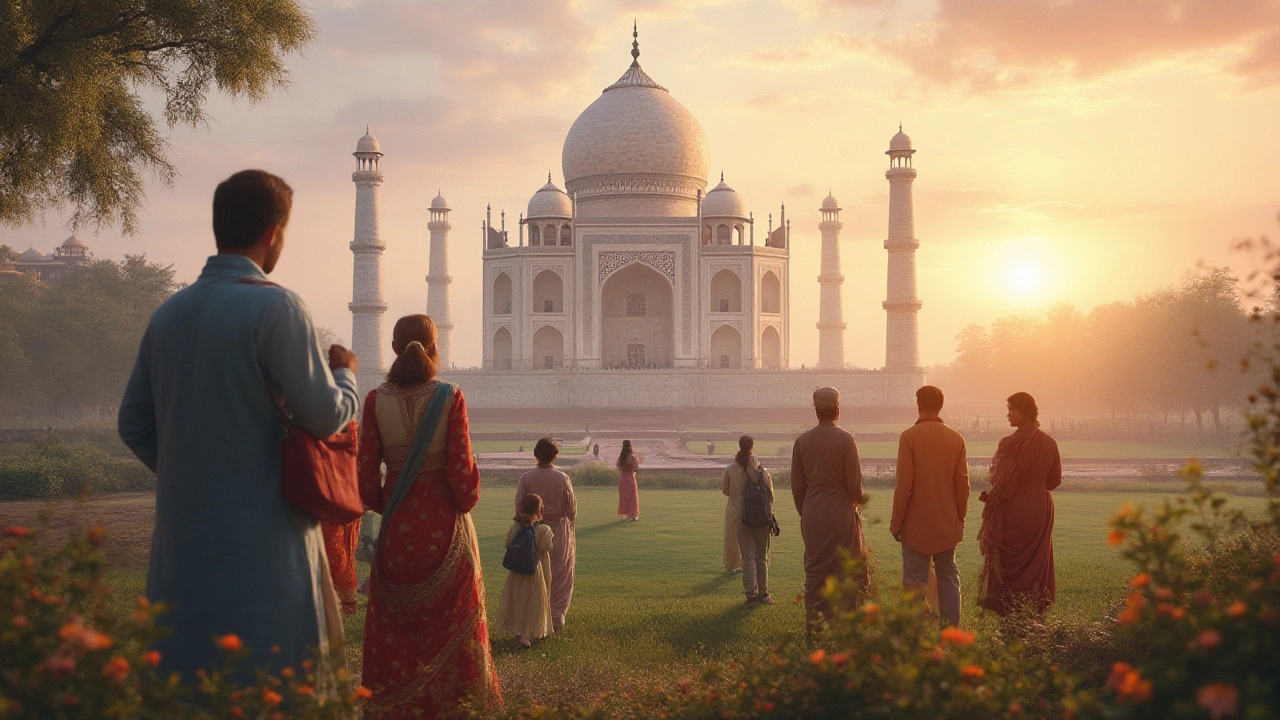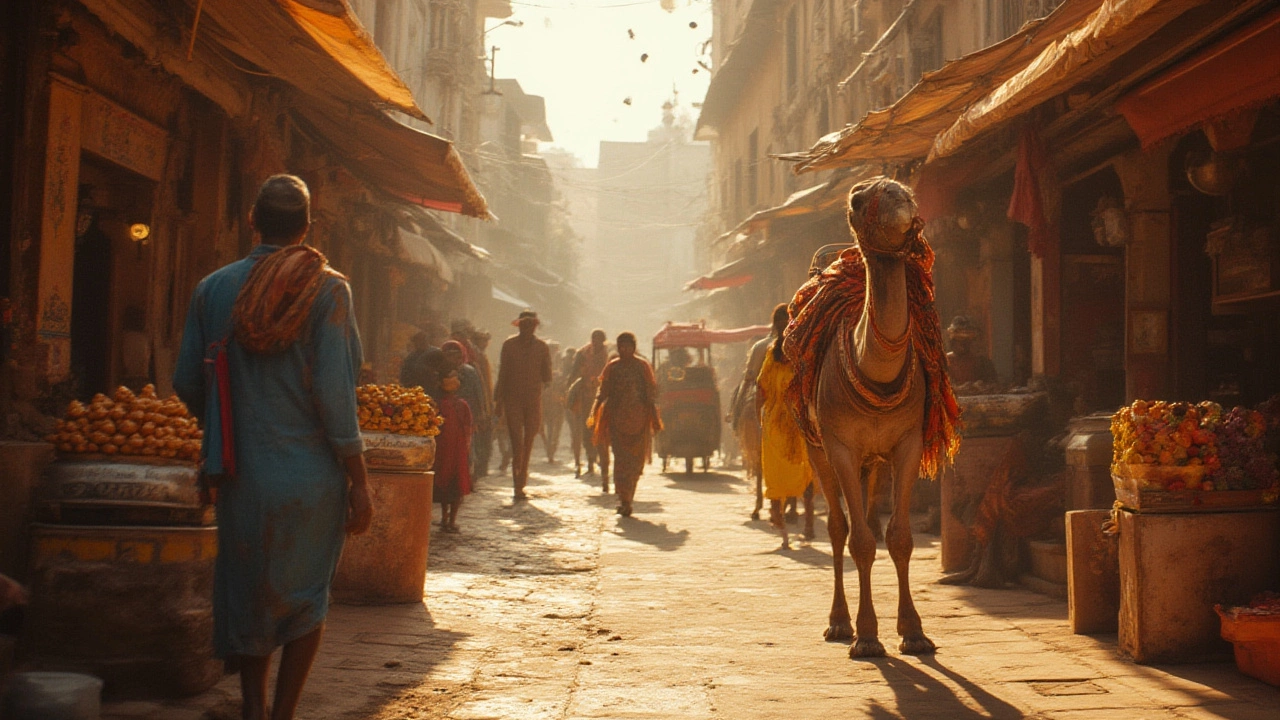Imagine standing in a railway station where the air smells like cardamom and diesel, then watching a train pull up exactly nine hours late, packed to the brim with families and chai vendors. That’s not a rare mishap—it’s just daily life when you’re touring India. There are more than 10 million international tourists who rumble, speed, and occasionally crawl their way across this country every year, and every single one comes away with wild stories—sometimes funny, sometimes frustrating, but never boring. The reality of tourism in India is more than postcard palaces and bucket-list Taj Mahal selfies. It's gritty, jaw-dropping, and bursting with unpredictable beauty—sometimes all at once.
Cultural Riches and Everyday Surprises
You can’t talk about tourism in India without talking about culture. This is a place where ancient traditions crash headfirst into modern lifestyles, and honestly? That’s a big reason people keep coming back. Hindu festivals like Diwali and Holi paint entire cities in neon colors. During Holi, it’s not unheard of to get caught in a rainbow crossfire of powdered dye, so wear something you don’t mind throwing away. In the south, Tamil Nadu’s Pongal festival feels more like a four-day harvest carnival, complete with bull-taming competitions and sweet rice dishes everywhere you turn.
If you’re a foodie, don’t expect Indian cuisine to be one thing. You might eat coconut-laden stews in Kerala, fiery vindaloo in Goa, and north Indian butter chicken, all in one week. Street food is something you can’t skip—just pick places with long lines (locals know where the stomach aches aren’t).
Music and dance performances are everywhere, from Bollywood-inspired shows in Mumbai to classical kathakali expositions in Kochi, complete with actors who can turn their eyes red just by rolling them a certain way. Museums in metropolitan cities like Delhi and Kolkata display relics from empires and kingdoms that, frankly, make European dynasties look like short-term tenants by comparison. And don’t get me started on temples. India has more than 2 million of them, ranging from serene hilltop shrines to gold-dipped giants like the Golden Temple in Amritsar. Sometimes, you almost trip into a 1,000-year-old sculpted wonder while just looking for coffee.
India’s blend of sacred and everyday life means you’ll stumble into religious processions, spontaneous cricket matches, and friendly wedding invitations (yes, really) while on your daily stroll. If you’re a woman, like me, you might get more attention—curious looks, kind questions, sometimes awkward photo requests, especially if you’re tall and pale like me. Most of it is harmless, but dressing modestly saves you hassle.
The Must-See Destinations—from North to South
Planning a trip to India is a bit like trying to fit a sprawling buffet onto one dinner plate. Want snowy mountains? That’s the Himalayas in the north. Dream of palm-fringed beaches? Kerala and Goa have you covered. Bustling cities? Mumbai and Delhi will knock your socks off.
- Delhi is a heady mix of ancient forts, mega-malls, and chatty rickshaw drivers. Must-see sites: Humayun’s Tomb, Jama Masjid, and Old Delhi’s spice bazaars. Pro tip: The Red Fort's Sound and Light show actually makes history dramatic.
- Agra houses the Taj Mahal, and yes, pictures don’t do it justice. Sunrise is the least-crowded time, and the white marble changes color with the light—it’s a little magic trick you don’t want to miss.
- The state of Rajasthan is a desert wonderland. Jaipur’s pink palaces, Jodhpur’s blue houses, and Udaipur’s lakeside mansions feel straight out of a fairy tale. You can stay in an actual palace for less than a four-star European hotel if you book right (check out heritage havelis in Jodhpur).
- The south gives you temple cities like Madurai and beach escapes like Varkala. Kerala is famous for houseboat rides through green canals—peaceful, if you ignore the busloads of wedding parties floating by.
- For wildlife, Ranthambore and Jim Corbett National Parks let you (maybe) spot tigers, but the real surprise is the sheer number of monkeys everywhere else. Hide your snacks or lose them!
There’s new adventure around every bend, but don’t forget modern infrastructure is patchy. Trains are classic but not always on time. Domestic flights can be a sanity-saver and are often dirt cheap if you buy ahead. Hotels range from rock-bottom basics to plush international chains. I lost count of how many times Elliot (my spouse) tried to plug in his phone before realizing every state uses a slightly different power socket.
| Destination | Best Time to Visit | Main Attractions | Average Backpacker Daily Cost (USD) |
|---|---|---|---|
| Delhi | Oct-Mar | Red Fort, India Gate, Chandni Chowk | 30 |
| Rajasthan | Nov-Feb | Jaipur, Jodhpur, Udaipur, Pushkar | 35 |
| Goa | Nov-Mar | Beaches, Old Goa churches, Night markets | 40 |
| Kerala | Dec-Mar | Backwaters, Kochi, Munnar | 35 |
| Agra | Oct-Mar | Taj Mahal, Agra Fort, Fatehpur Sikri | 25 |

Travel Tips: What Every Tourist Should Know
India doesn’t just wake you up—it throws a glass of cold water in your face. That can be thrilling, but only if you’re ready for a few curveballs. First: the crowds. If you’re used to having personal space, you’ll need to get creative. Trains during festival season are legendary for their human-to-suitcase ratio. When I traveled during Diwali, I once counted 16 people standing in a space meant for four. If crowds make you anxious, book flights or buses in advance and consider private taxis for day trips.
Scams exist, especially in major cities. Famous ones: helpful “guides” who claim tourist sites are closed but know an “uncle” who has a shop to visit instead. Real guides display official badges, but double-check anyway. When in doubt, trust your instincts over flattery. Bargaining is expected everywhere except malls and chain stores. My tip? Start at half the quoted price and negotiate with a smile.
Food safety: If you’re not used to spicy or unfiltered food, start slow. Only drink bottled water (always check the seal), and avoid ice outside high-end places. Roadside snacks are tempting—just eat at busy stalls with a turnover so high you know it’s fresh. Most travelers I met had at least one “Delhi belly” incident; pack Imodium, but don’t let fear stop you from eating like a local.
India’s weather can floor you. The north bakes in summer and freezes in winter; the south steams year-round, with sweaty monsoons from June to September. Always check regional forecasts—people notoriously underestimate how cold Ladakh gets at night or how drenching Mumbai’s pre-monsoon ‘showers’ can be. Sunscreen and bug spray are your best friends.
Dress codes lean conservative. Covering knees and shoulders keeps you cooler (and gets less attention). Temples and some mosques may require headscarves for women and will always ask you to remove shoes. Never point your feet at a statue or altar—major faux pas.
Getting around is an adventure on its own. Rickshaws are cheap but insist on the meter (or agree on a fare first). India’s legendary trains have classes from basic (think wooden benches) to luxury. And yes, sometimes cows do hold up traffic in the middle of New Delhi. Always leave extra time for journeys.
Language isn’t a hurdle. India has 22 official languages, but English is widely spoken, especially at tourist destinations. Learning a few Hindi words—like ‘namaste’ (hello) and ‘dhanyavaad’ (thank you)—is appreciated and gets you smiles.
Respecting local traditions goes a long way. Sometimes you can join a religious festival or a family dinner by striking up a conversation, but ask first before photographing people, and be aware of holy days—some temples close or restrict access then.
How Tourism Shapes India…and What Travelers Leave With
Tourism isn’t just about seeing monuments. In India, it’s a two-way mirror: travelers bring in fresh perspectives, but they also leave changed by what they discover here. The latest stats peg tourism as a $215 billion industry, making up almost 7% of India’s GDP. From homestay families in Ladakh to artisans in Kutch, millions of people rely on those annual waves of travelers to keep age-old crafts, dance forms, and food traditions alive.
There’s also a flip side—overtourism in places like Agra and the beaches of Goa creates crowds, pollution, and higher prices. Mindfulness matters: If you want an authentic experience, try spending time in less-visited regions like Nagaland or the hills of Himachal Pradesh. Sustainable tourism projects, like treehouses in Kerala or desert eco-camps near Jaisalmer, offer unique, low-impact stays.
Travelers often buy more than souvenirs—they take home stories. I’ll never forget the night I joined a roadside wedding feast, still sticky with Holi colors, exchanging stories with strangers-turned-friends over spicy samosas and plastic cups of sweet chai. Elliot still brags about outbargaining a Jaipur silk vendor by quoting Bollywood movie lines. Toss expectations out the window and you’ll find India gives you surprises at every turn—good, challenging, and sometimes life-changing.
Whether you wander in search of dazzling palaces, get blissfully lost in a spice market, or spend your evenings watching street cricket beneath the shadow of 500-year-old mosques, one thing’s for sure: India isn’t about ticking off sights, it’s a place that pulls you into its rush and rhythm. One minute, you’re elbow-to-elbow with thousands on a pilgrimage; the next, you’re silent in awe, alone before a mountain sunrise.
So what’s tourism like in India? Forget neat little boxes. It’s chaos you’ll want more of—and trust me, there’s no other trip on earth quite like it.
